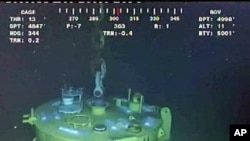BP oil company says a concrete cap appears to be holding in the top of a blown-out well in the Gulf of Mexico. The company is looking forward to a second operation later this month to permanently seal the well.
Offshore crews pumped concrete into the top of the well on Thursday in an effort to ensure the damaged well never leaks oil into Gulf waters again. The cement was the second phase of a so-called "static kill" operation that involved injecting heavy mud to counter the pressure from oil.
Engineers said the cement would cure for about 24 hours and then they would perform a pressure test to check the seal.
BP's chief operating officer, Doug Suttles, said initial signs suggested the concrete seal was holding as engineers expected. "All the indications so far look very encouraging. What we need to do is get that pressure test done. We are continuing on with the relief wells."
BP crews have resumed drilling a relief well that is nearing the bottom of the damaged well. Suttles said the relief well should be completed later this month, when crews will pump mud and cement into the bottom of the well pipe.
Retired Coast Guard Admiral Thad Allen is the top U.S. official overseeing the response to the leak. He said the job of killing the Macondo well is not complete until the relief well is drilled into the outer well pipe, or annulus, and filled with mud and cement.
"We are unequivocally committed to completing the relief well and drilling into the annulus [outer well pipe] and cementing the annulus as the bottom portion of this kill," said Allen. "There is no indication this should be completed with a static kill from the top."
Meanwhile, BP officials said they are shifting the focus of clean-up efforts, because there have been no signs of oil on the open seas for several weeks. BP crews capped the damaged well in mid-July, but experts fear more than 1 million barrels of oil may remain in the environment.
BP's Suttles said clean-up crews are continuing to monitor Gulf coastline for signs of tar balls and other forms of oil residue. But he said they are removing thousands of meters of containment boom, used to trap oil on the water, because of the risk of hurricanes.
"This boom has played a valuable role in the response, but now the oil has gone from the surface and we enter the severe weather season. This same boom becomes a risk and a hazard. It can create damage in the marshes; it can wash up on the road; it can wrap around the docks," said Suttles.
BP has set aside $30 billion in a fund to support clean-up work and make claim payments to businesses affected on the U.S. Gulf coastline.
BP was leasing the Deepwater Horizon drill rig, when it exploded and sank on April 22 while completing work on the Macondo well. Eleven workers died in the accident.
BP Says Cement Cap Appears to Hold in Gulf Well










